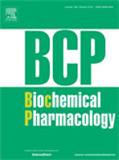
《生物化學(xué)藥理學(xué)》是一份國際期刊,出版的藥理學(xué)研究成果來自于運(yùn)用生物化學(xué)、生物物理學(xué)、分子生物學(xué)、遺傳學(xué)、結(jié)構(gòu)生物學(xué)、計(jì)算機(jī)模型和/或生理學(xué)等學(xué)科的調(diào)查。對完整的動物、器官、細(xì)胞、亞細(xì)胞成分、酶或其他細(xì)胞分子和模型系統(tǒng)的研究報(bào)告如果定義了藥物作用的機(jī)制,是可以接受的。描述性數(shù)學(xué)模型包括那些涉及計(jì)算機(jī)技術(shù)的模型也受到歡迎。使用藥物闡明生物體生理和行為機(jī)制的實(shí)驗(yàn)也在該雜志的范圍內(nèi)。一般來說,只有當(dāng)藥物和代謝產(chǎn)物在體液中的濃度有助于理解生物化學(xué)和生物物理機(jī)制時(shí),才會被接受。但是,編輯保留發(fā)表該領(lǐng)域內(nèi)任何重要論文的權(quán)利。只有英文稿件才會被考慮或發(fā)表。該雜志出版了以下類型的通訊(1)全文論文。這些工作包括提出與從事這項(xiàng)研究的調(diào)查人員提出的問題有關(guān)的原始調(diào)查結(jié)果。(2)短通信。這些作品包括范圍較窄但質(zhì)量相同的原創(chuàng)作品。根據(jù)定義,這些論文比完整的手稿短。(3)快速通信。這些促進(jìn)了在《日刊》范圍內(nèi)迅速傳播及時(shí)和重要的意見。稿件必須以英文提交,并將根據(jù)其當(dāng)前的重要性,作為快速通訊的依據(jù),判斷是否適合出版。他們應(yīng)該寫清楚地強(qiáng)調(diào)研究的新穎方面。這些標(biāo)準(zhǔn)將嚴(yán)格執(zhí)行。(4)評注是委托評審的短文(長度在3000-5000字之間)。它們被設(shè)計(jì)成對選定主題的編輯聲明,而不應(yīng)是詳盡的評論。評論主要是為了激發(fā)思考。它們可能是有爭議的,既可以集中在活動較多的領(lǐng)域,也可以將注意力吸引到相對被忽視的領(lǐng)域,在這些領(lǐng)域中有機(jī)會也有必要進(jìn)行生化藥理學(xué)的研究。特別值得歡迎的是,作者將在評論中就他們所報(bào)道的主題的狀況提出他們個(gè)人的看法,并就該主題在不久或遙遠(yuǎn)的將來可能會走向何方提出他們的看法。特別鼓勵(lì)作家們對流行的教條提出異議。
Biochemical Pharmacology is an international journal which publishes research findings in pharmacology deriving from investigations that employ the disciplines of biochemistry, biophysics, molecular biology, genetics, structural biology, computer models and/or physiology. Reports of studies with intact animals, organs, cells, subcellular components, enzymes or other cellular molecules and model systems are acceptable if they define mechanisms of drug action. Descriptive mathematical models including those involving computer techniques are also welcome. Experiments involving the use of drugs to elucidate physiological and behavioral mechanisms in living organisms are also within the scope of the journal. In general, papers that record concentrations of drugs and metabolites in body fluids will only be accepted if they contribute to an understanding of biochemical and biophysical mechanisms. The Editors, however, reserve the right to publish any papers of major interest in the field. Only contributions in English will be considered or published. The journal publishes the following types of communications (1) Full-length Papers. These consist of a body of work presenting original findings relating to the question proposed by the investigators undertaking the research. (2) Short Communications. These consist of an original body of work of narrower scope but of the same quality as the above. By definition, these papers are shorter than full-length manuscripts. (3) Rapid Communications. These promote rapid dissemination of timely and significant observations within the scope of the journal. Manuscripts must be submitted in English and will be judged as appropriate for publication as rapid communications on the basis of their immediate importance. They should be written to emphasize clearly the novel aspects of the research. These criteria will be applied strictly. (4) Commentaries are short commissioned review articles (3000-5000 words in length). They are designed to be editorial statements on selected topics, and should not be exhaustive reviews. Primarily, Commentaries are intended to stimulate thought. They can be controversial, and can either focus on areas subject to much activity, or draw attention to relatively neglected fields in which there is both the opportunity and the need for research in biochemical pharmacology. Particularly welcome will be Commentaries in which authors present their personal view on the state of the subject on which they are reporting, and give their view as to where in the near or distant future the subject may be moving. Authors are especially encouraged to take issue with popular dogmas.
SCI熱門推薦期刊 >
SCI常見問題 >
職稱論文常見問題 >
EI常見問題 >